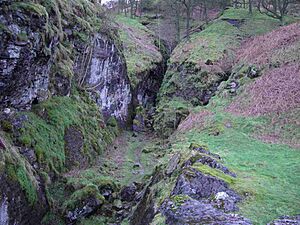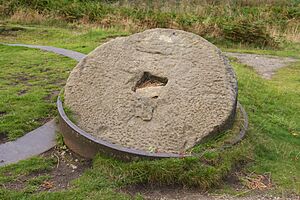Odin Mine facts for kids
Odin Mine is a very old lead mine in the beautiful Peak District National Park in England. It's located near the village of Castleton. This mine is believed to be one of the oldest lead mines in England, with its first mention in official records dating back to 1280. The entire mine site is a Scheduled Ancient Monument, which means it's protected because of its important history. It's also special for its unique plants and rocks, being part of the Castleton Site of Special Scientific Interest.
Contents
Discovering Odin Mine's Past
The exact beginnings of Odin Mine are a bit of a mystery! Many old books say that the Romans might have started mining here. Later, the Saxons and Danes might have worked it too. While there isn't much written proof, it's clear the mine is very, very old.
Why is it called Odin Mine?
The name "Odin" is often linked to the Danes. Odin was the chief god in their ancient stories. Before the 1800s, the mine was often called "Oden" in mining papers, which sounds even more like the Danish spelling.
Early Mining Days
The first time Odin Mine shows up in official papers was in 1280. A man named John of Bellhag was on trial for hunting near the mine's entrance. In those early days, before explosives were invented, miners used a clever method called "fire setting." They would light big fires against the rock overnight to heat it up. The next morning, they would pour water on the hot rock. This sudden cooling made the rock crack and shatter, making it easier to dig out the lead.
Busy Times at the Mine
The Romans used a lot of lead, especially for water pipes in their homes. They mined a lot of lead ore, called galena, when they were in Britain. So, it's very possible that Odin Mine was indeed worked by the Romans.
The mine became very busy again in the 1700s. A man named Richard Bagshawe, who later became a very important person in Derbyshire, owned a big part of the mine. His family kept their interest in Odin Mine until the 1850s. Throughout the 1700s, the mine was always working. Each year, they dug out between 100 and 800 tonnes of lead ore. In 1706, miners found a very rich vein of lead. At that time, 41 men and eight women were working at the mine. The mine tunnels reached about 500 metres deep into the hillside, under Mam Tor.
Solving Water Problems
Mining deep underground often means dealing with water. To help drain the mine, a plan was made in 1772 to build a long tunnel called a "sough." This tunnel would carry water away from the mine. It took many years to finish, probably not until the 1840s. It started from Hollowford Brook in Castleton and went up to the mine workings.
The mining process created huge piles of waste rock, called "spoil." In 1802, this spoil was put to good use! The company building a new road between Manchester and Sheffield used the spoil to help construct the road. Later, people discovered that the spoil also contained valuable minerals like fluorspar, calcite, and barite. These were dug out in later years when their worth became known.
Lead mining at Odin Mine stopped in 1869. However, some work happened again in 1908 and 1909. During this time, a lot of fluorspar and barite were dug out from a part of the mine called the Mam Engine Shaft.
How the Lead Formed (Geology)
The lead veins in the Castleton area formed about 280 million years ago. Imagine huge cracks, or "faults," in the local Carboniferous limestone rock. Hot, mineral-rich liquids, pushed up from deep inside the Earth, flowed into these cracks. The lead and sulphate in these liquids combined to form the lead ore called galena.
In its busiest days, Odin Mine was a huge network of tunnels and shafts. It stretched about 1500 metres into the rock under the nearby Mam Tor. At first, miners dug the lead from the surface, creating a big gorge in the hillside. They even used a special channel, called a "leat," to move water away and keep the digging area dry. Later, miners followed the lead veins underground. The lead vein can still be seen on the surface at the mine's entrance. It then goes underground, heading west under Mam Tor. Old maps from 1769 show that there were several smaller veins branching off from the main lead workings.
Inside the mine, there are also some small caves. The most famous one is Odin Cave, which miners called Gank Hole. It formed when groundwater slowly carved out a space between big limestone boulders. Even though the famous Blue John stone is mined nearby, there's no sign that it was ever found at Odin Mine.
Odin Mine Today
Today, the site of Odin Mine is owned by the National Trust. You can visit the limestone gorge, which was where the early miners first started digging before they went underground. It now looks like a natural valley, with plants growing over the old workings. To the left of the gorge, you'll find Odin Cave. It's about two metres wide and goes about 10 metres underground.
The remaining piles of waste rock, called "spoil heaps," are now a protected archaeological site. They are also home to many different kinds of plants. You might see Birdsfoot Trefoil, Eyebright, Wild thyme, and the Common spotted orchid. Some special plants, called "metallophytes," can even grow in soil that has high levels of metal. These include Spring Sandwort and Alpine Scurvy-grass.
You can still see a large stone crushing wheel at the site. This wheel, made of gritstone, is 1.75 metres wide and has an iron rim and track. It was used to crush the lead ore after it was dug out of the ground. This crusher was built in 1823 and cost £40 at the time.



